Examples of feeders
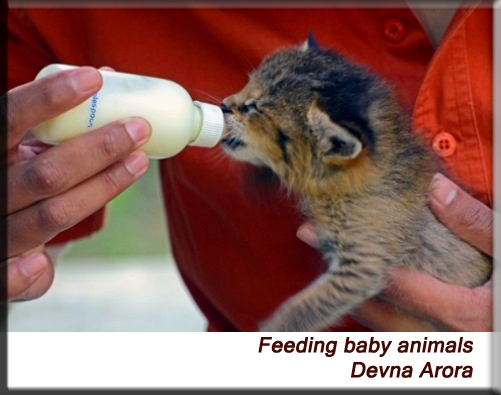
What constitutes a feeder?
Any appropriate apparatus that can be used comfortably to feed a baby animal qualifies as a feeder. Various instruments including baby milk bottles, drink’s bottles, syringes, pipettes, forceps, modified spoons and even traditional oil lamps have been used through time to feed orphaned baby animals. Fortunately, with the increase in the number of people caring for the different forms of life, specialized feeders for the different species are now readily available in the market.
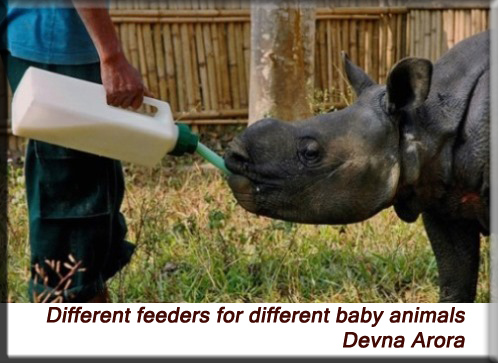
Essential criteria a feeder must fulfill
• Suitable and comfortable to use
– both for the animal and the foster
• Allows cleaning, disinfection and sterilization with ease
• Mimics the teats and flow of milk of the respective species
• Fills adequate quantity of feed for an entire feed
Feeders for mammals
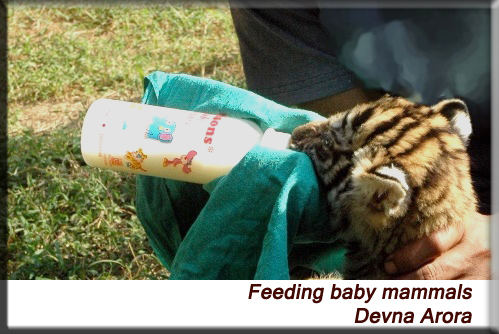
A wide variety of feeders, of different sizes and with different teats (nipples), are currently available in the market. The most easily and universally available of these are human baby milk bottles – standard milk bottles, nursers, feeding cups or bottles designed for premature babies. A wide variety of teats in various shapes, sizes and materials are also available. Although most of these may be suitable for similar sized mammals babies, like panther cubs or older bear cubs, specially designed teats may be more suitable for smaller sized babies.
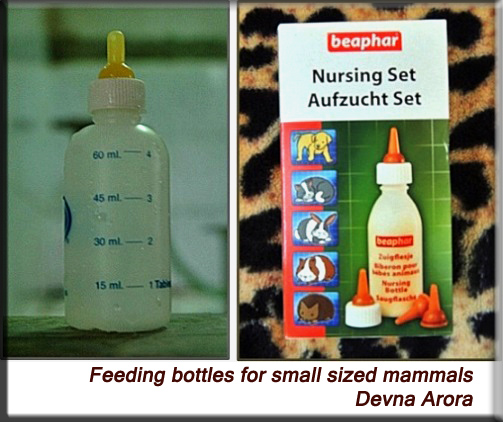
The next most commonly available is feeding bottles for (small) companion animals. These are readily available at most veterinary clinics and pet stores and are ideal for puppies, kittens and other similar sized animal babies.
A third alternative is hand-feeding equipment for farm animals – lambs, foals and calves. Feeders designed for lambs will be appropriate for any other similar sized species including wild goats and most species of smaller deer. Feeders for foals will of course be appropriate for equids and other larger deer while those for calves will not only be suitable for wild bovids but also other large herbivores including elephants and rhinos. These again are available in various capacities and with a variety of teats to suit different species.
Lastly, let’s look at feeding bottles and other options for teeny mammals like mice, squirrels, hedgehogs and other similar sized babies. These are specialized feeders for wildlife and often only available with retailers for wildlife/rehab supplies.
A feeder for small mammals may be also be fashioned using a pipit or a syringe with a scalp-vein set. Although droppers may be used to feed small babies, they are not available sterile and due to the quality of plastic used, they are extremely difficult to sterilize and hence not recommended.
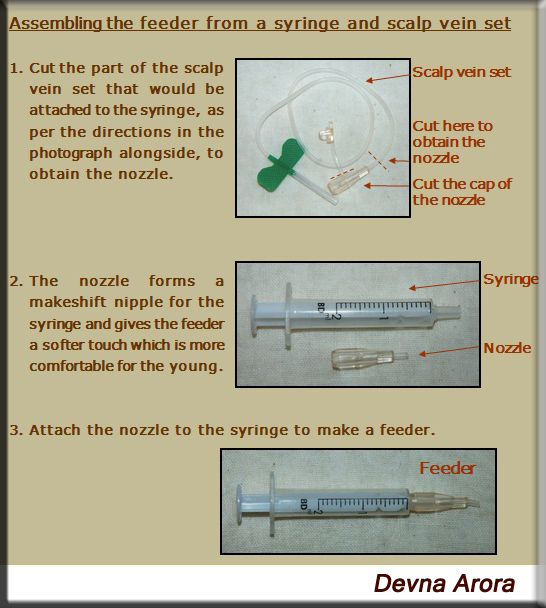
Choosing the right feeder and teat
Unfortunately, the first and foremost consideration is availability. Although standard feeding bottles are universally available, specialized feeders are only available at selected outlets and countries and can prove to be very expensive to import. Another point of consideration is that no feeder lasts forever – they all have to be changed at periodic intervals, while teats have to be changed frequently. An important consideration while purchasing a feeder is also the availability of teats. A feeder is no good without the teat and you must ensure to order adequate teats while purchasing the feeder.
Different types or sizes of feeders may be appropriate for different species at different ages. Younger babies often require smaller feeders while older ones would prefer bigger feeders with larger teats. The feeder must be of an appropriate size and contain as much feed as the baby requires in one sitting as many babies refuse to feed once the feeder is pulled away for a refill. Soft squeezable bottles may be preferred to the normal ones if you are dealing with a fussy or weak animal – the extra squeeze can make a huge difference in stimulating the baby to feed. Syringes serve a similar purpose as the feed can be pumped in the case of a weak baby.
Teats are just as important as feeders, esp. when dealing with neonates. The teat hole size must also be carefully adjusted to suit the flow of formula required by the baby. Larger holes can easily lead to aspiration while smaller holes will impede the flow of formula resulting in frustration and even complete abandonment of the feed.
Another important consideration that a feeder must satisfy is the suckling reflex. Babies often get their feed a whole lot faster from a feeder than they would if they were suckling on the mother. Biologically, babies are programmed to suckle longer to get adequate nutrition but may not always be able to do so. Ideally and where feasible, the feeder must satisfy both the baby animal’s nutrition needs and its suckling reflex.
N.B. Baby animals sometimes suckle due to insecurity or want of the mother – this must not be confused with an unsatisfied feeding reflex.
Vigorous feeders
Although it a blessing to have baby animals that suckle enthusiastically, caution must always be practiced with such babies as they are likely to ingest the nipples just as enthusiastically. Using smaller sized nipples may make it easier for the animal to ingest them as their mouth envelops the entire nipple while suckling and may swallow the nipple before giving you the chance to realize and react.
Feeders for birds
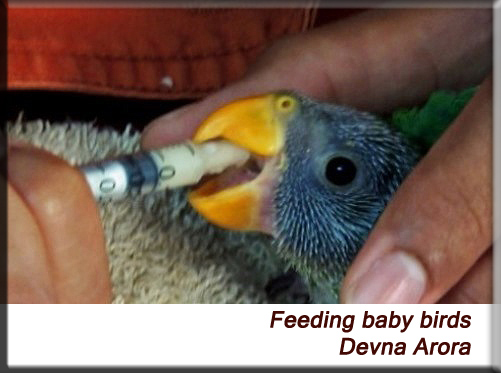
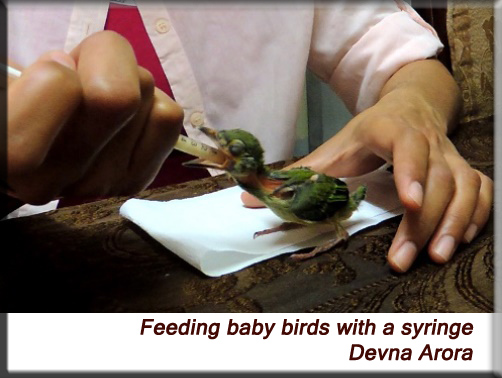
Unlike baby mammals, birds are NEVER given milk or milk based formulas. They may nonetheless be given formulas with a syringe – most commonly done in the case newborn chicks of smaller species of birds, but they will not suckle on the syringe as a baby mammal does – the formula has to be dropped or emptied in the chick’s mouth.
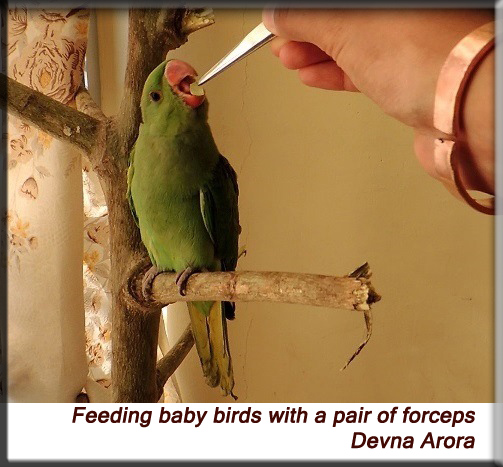
Chicks, esp. once older, are normally fed with a pair of forceps or hand puppets. Ensure the use of blunt equipment, like a blunt-tipped forceps, when feeding chicks to prevent accidentally scratching or hurting the chicks. You may even choose to feed the baby by hand but it is best avoided in the case of wild animals to prevent excessive bonding.
Universal feeders
Feeders like syringes, spoons or bent spoon feeders can be comfortably used for both mammals and birds.
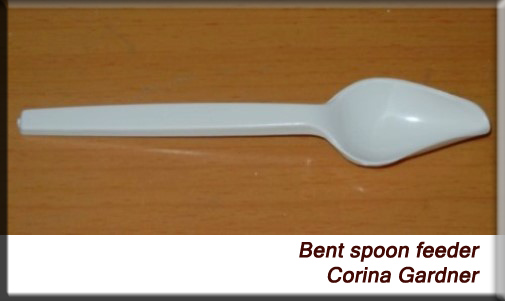
People have even resorted to other equipment like traditional oil lamps in emergencies - it acts like a funneled spoon and channels the milk to the baby’s mouth without spilling too much. Although I will not recommend this for hygiene purposes, clean hands may be dipped into formula or milk and offered to the baby if nothing else is available – although I have reservations about this, it is much safer than using cotton wool or buds, matchsticks, etc.
Sterilizing the feeders
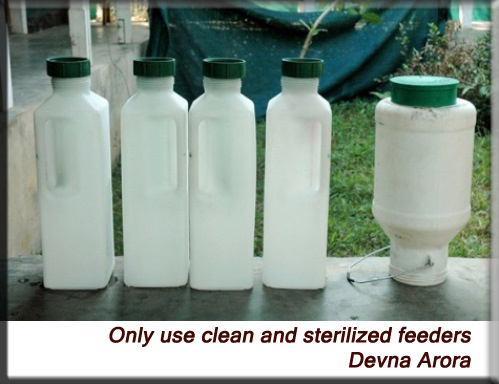
It is important to maintain extremely high levels of hygiene when feeding baby animals. The buildup of bacteria in feeders that have not been sterilized will lead to gastro-intestinal infections. Since the gut wall of younger animals is much more permeable than it is in adults, toxins from infections in the gastro-intestinal tract can easily seep through the gut wall and cause systemic toxemia or generalized infections in young animals. It is therefore absolutely essential to sterilize the feeders after every meal. An alternative to this is using disposable feeders but it is expensive and may be practical only in the case of syringe feeders.
While large feeders can be washed using disinfectants and bottle brushes, all teats and small feeders can be sterilized using a simple steam sterilizer or an ordinary kitchen pan. All parts of the feeder must be detached and rinsed thoroughly in normal water, and then immersed in water and boiled for 5 minutes after the water first comes to a boil.
Feeding bowls, dishes, troughs, and platforms
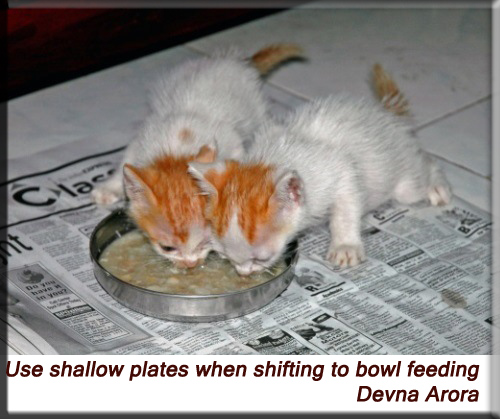
Feed or formula too may be offered in bowls but must be done in shallow plates or bowls to begin with and given small quantities so they don’t aspirate the feed. It may be easier to assist the young when shifting them onto bowl feeding, for example, by holding the bowl so it doesn’t keep rotating or tipping over repeatedly.
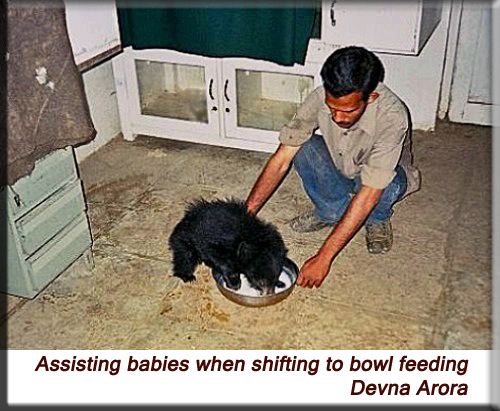
The only drawback is that bowl feeding may not always permit recording of the precise amount of feed consumed and the youngsters may inevitably spill some feed in their excitement. This is not significant for young that have stabilized, are healthy and are feeding well. They may simply be given additional feed to compensate for the spilling.
Once older and weaned, all young animals are sifted to bowl feeding. Feeding bowls, dishes, troughs and platforms are extremely helpful at this stage and are easier to clean too as they do not have to be sterilized.
Feeding many individuals together
Babies of the same litter may be fed using one bowl feeder only as long as each and every baby is healthy and feeding well. Such is technique is safest to use during the last stage of weaning where the importance of the quantity of milk feeds is drastically reduced and of little importance. Babies are also consuming adequate food and not completely reliant on formula.
When using a single bowl for many young, they must always be given extra feed so even the smallest of the lot have enough opportunity to consume a tummy full. It is, nonetheless, be advisable to feed the young separately if they are fairly disproportionate in size as they bigger ones will tend to dominate over the smaller ones and push them aside.
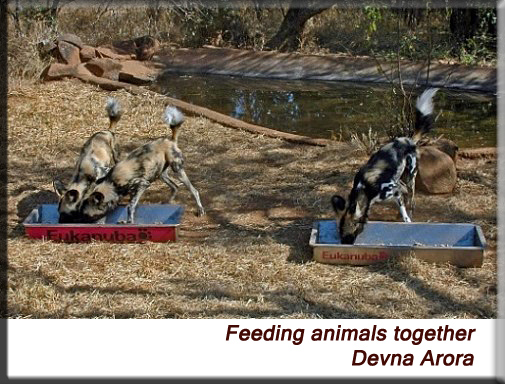
Scattering food around
Once the process of rehabilitation begins, reliance on feeders again reduces and food is scattered in different places each day to encourage the animals to learn to find their food. This is also a good exercise for captive animals are it keeps them engaged and gives them something to do.
Please refer to our page on
Nutritional Basics
for more information.
Water bowls
Like feeding bowls, water too must be given in shallow plates when introducing young babies to water. Inexperienced babies tend to dip their nose deep in the water and may accidentally inhale the water – this is not only dangerous but also frightening for them. Offering water in shallow plates forces the babies to angle their mouths and keeps their noses from dipping into the water.
Once older, they may be given appropriately sized bowls or natural ponds. Caution must be taken to keep any animal from drowning in the water if using larger bowls for any reason.





